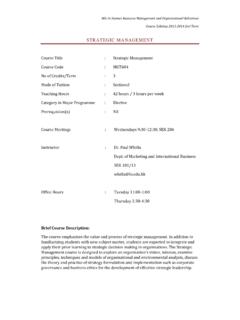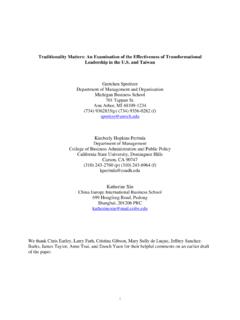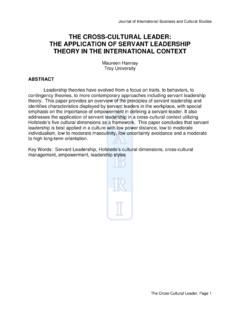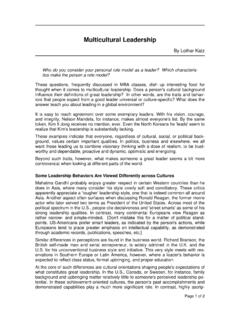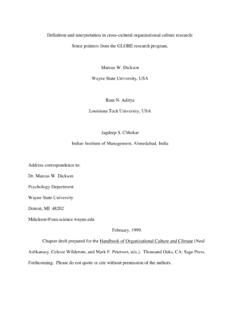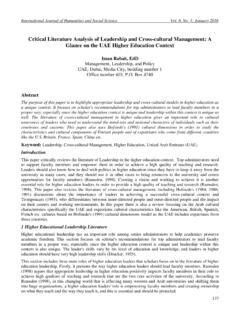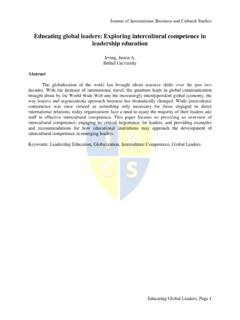Transcription of Cross-Cultural Leadership: Goal Interdependence and Leader ...
1 Cross-Cultural leadership : Goal Interdependence and Leader -Member Relations in Foreign Ventures in China Yi Feng Chen Department of Management, Lingnan University, Hong Kong (852)2616-8308, Fax (852)2467-0982 Email: and Dean Tjosvold Department of Management, Lingnan University, Hong Kong (852)2616-8324, Fax (852)2467-0982 Email: September, 2004 Note: This work has been supported by the Research Grants Council of the Hong Kong Special Administrative Region, China, (Project No: LU3013/01H) to the second author. Abstract Cross-Cultural leadership may be particularly challenging, as there are significant barriers to developing an effective relationship between managers and employees.
2 Two hundred and thirty Chinese employees from various industries in Chinese Mainland were surveyed on their relationship with their American, Asian, and Chinese managers. Results, including structural equation analyses, support the hypotheses that cooperative, but not competitive or independent, goals help employees and their foreign managers develop a quality Leader -member exchange relationship, which in turn improve Leader effectiveness, employee commitment, and future collaboration. Cooperative goals may be an important way to overcome obstacles and develop an effective Leader relationship within and across cultural boundaries.
3 2 Cross-Cultural leadership : Goal Interdependence and Leader -Member Relations in Foreign Ventures in China China has become the largest receiver of foreign direct investment (FDI) during the first years of the twenty-first century (UNCTAD, 2002). Many companies are developing subsidiaries and joint ventures in China to lower costs and participate in the global marketplace. Long-term success in China depends on the recruitment and retention of a local workforce (National Foreign Trade Council and Towers Perrin, 1998). To make these organizations effective, multi-national managers must successfully lead local employees.
4 The relationship between managers and employees has been considered critical for effective leadership , especially in collectivist Asia (Brower, Schoorman, and Tan, 2000; Graen and Uhl-Bien, 1995; House, Wright, and Aditya, 1997; Hui and Law, 1999; Setton, Bennett, and Liden, 1996; Schriesheim, Neider, and Scandura, 1998; Uhl-Bien and Maslyn, 2000). However, researchers have found that a manager s culture strongly influences his/her attitude and behavior (Mason and Spich, 1987). Developing an effective relationship between managers and employees is difficult, especially when they have diverse cultures.
5 An action that appears very reasonable to the manager can appear biased, illogical, and unfair when viewed from the perspective of an employee from another culture (Adler, 2002). cross -culture researchers have recently argued for the need to develop frameworks that can help diverse people overcome obstacles and work together effectively (Bond, 2003; Smith, 2003). However, few studies have documented ways to promote effective Cross-Cultural leadership . To fill this gap, this study investigates the proposition that cooperative, rather than competitive and independent, goals promote a high quality Leader -member 3exchange (LMX) between foreign managers and Chinese employees.
6 This relationship, in turn, facilitates Leader effectiveness, employee commitment, and future collaboration between foreign managers and Chinese employees. In addition to exploring ways to promote effective Cross-Cultural leadership in Chinese contexts, this study contributes to the existing literature by empirically documenting the utility of universal theories (namely the theory of cooperation and competition and the theory of Leader -member exchange), to our understanding of Cross-Cultural leadership . It is a Cross-Cultural study of American managers and Chinese employees as well as a study of LMX relationships between managers and employees in a Chinese context.
7 Theory of Leader -Member Exchange The Leader -member exchange theory proposes that the quality of the relationship between a Leader and individual employees determines Leader effectiveness (Graen and Uhl-Bien, 1995). Graen and his colleagues ( Dansereau, et al., 1975; Graen and Schiemann, 1987; Liden and Graen, 1980) suggest that because of constraints of limited time and energy, leaders develop close relationships with a few subordinates and share their personal and positional resources to help these employees perform. leaders tend to develop and maintain LMXs with their subordinates that vary in quality, ranging from in-group to out-group.
8 In-group exchange is a high quality relationship characterized by high levels of information, communication, mutual support, informal influence, trust and negotiating latitude. On the other hand, out-group exchange is a low quality relationship characterized by mistrust, formal supervision, little support and attention. 4 Research also indicates that LMX very much affects discourse patterns (Fairhurst, 1993; Fairhurst, et al., 1987), persuasion strategies (Krone, 1992), conversational resources, , interpretive and conversational procedures, (Fairhurst and Chandler, 1989), and relational maintenance (Waldron, 1991).
9 Studies suggest that high quality LMX relationships contribute to organizational citizenship behavior where employees perform useful tasks even though they are not prescribed by their roles (Bauer and Green, 1996; Boyd and Taylor, 1998; Deluga, 1998; Duarte, et al., 1994; Gerstner and Day, 1997; Graen and Uhl-Bien, 1995; Howell and Hall-merenda, 1999; Setton, et al., 1996). In addition to research in the West documenting the value of quality LMX relationships (Boyd and Taylor, 1998; Deluga, 1998; Gerstner and Day, 1997; Gersick, Bartunek and Dutton, 2000; Howell and Hall-Merenda, 1999), quality relationships have been found useful in collectivist China (Hui and Law, 1999).
10 Wakabayashi and Graen (1984,1988) also argued that recently hired Japanese employees who had developed high quality LMX with their immediate supervisors were positioned as in-group members that made them central to the management system. In contrast, those who had failed to develop high quality LMX were positioned as out-group members and outside the core of the management system. The quality of the vertical dyad exchange was found to have a major impact on motivating newcomers to work, mentoring their behavior toward the attainment of career goals , and contributing to their promotion and bonus.





